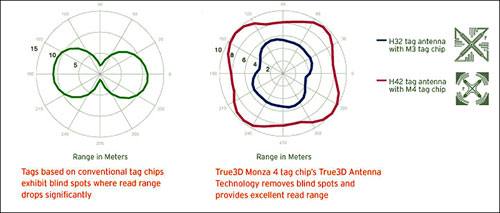Impinj, a Seattle, Wash., provider of passive EPC Gen 2 ultrahigh-frequency (UHF) radio frequency identification systems, today announced the availability of RFID chips with more memory, innovative privacy features and, according to the company, greatly improved performance. The Monza 4 family of chips, Impinj reports, is designed for end users that require more than just a license plate tag, and will sell for a premium over the Monza 3 chip, which Impinj will continue to sell as well.
“We think this is an important addition to our product portfolio,” Impinj’s president and CEO, William T. Colleran, told RFID Journal, “and will meet the needs of end users who require more memory, better performance, or enhanced privacy features.”
|
|
Impinj tag read range: Monza 4 versus conventional. Click here to view a larger version. (Source: Impinj)
The new family of chips includes four different models:
• Monza 4D, with 128 bits of EPC memory, 32 bits of user memory and a 96-bit tag identifier (TID)
• Monza 4U, with 128 bits of EPC memory, 512 bits of user memory and a 96-bit TID
• Monza 4E, which has up to 496 bits of EPC memory (the standard limits tags to 496 bits), 128 bits of user memory and a 96-bit TID
• Monza 4QT, with 128 bits of EPC memory, 512 bits of user memory, a 96-bit TID and a new, patent-pending private feature set that Impinj calls “QT technology”
The 4U and 4QT tag chips offer the ability to independently lock four fixed, 128-bit sections of user memory—an option within the Gen 2 spec known as “block permalock.” This feature is useful for some applications, such as tracking goods in a supply chain, in which various participants along the chain might want to record data to the chip, but not necessarily have it be openly available to all parties.
“The decision to introduce four chips flowed from observations of applications in the field using different kinds and amounts of memory,” Colleran says. “Some companies only need a serial number or license plate tag, some want more user memory for quickly retrieving information without accessing a back-end database, and some want a longer EPC. As we tried to figure out the best way to meet all these needs, it quickly became clear that we would need more than one chip to do it.”
In addition to having more memory, all four chips support new “True3D” antenna technology. With True3D, Impinj indicates, each chip has two radios that can attach to separate antennas, thereby allowing tag manufacturers to create new antenna designs enabling the tag to be read regardless of its orientation.
The Monza 3 chip has the ability to support a dual dipole antenna that allows energy to be captured from any angle, Colleran says, but Monza 4 chips optimize the ability to capture energy from any angle by having two separate radios on the chip that act in unison when communicating with the reader.
“It’s like having two separate tags in different orientation, but they share the same information and communicate with the reader as one,” Colleran says. “In fact, it’s better than two tags, because if both antennas are angled at 45 degrees from the reader, you actually get better performance than one tag angled at 90 degrees from the antenna.”
According to Colleran, with True3D antennas, the Monza 4 chips deliver a read range 66 percent better than that of their closest competitor, based on internal tests conducted under the same conditions. Additionally, he says, the chips have more than double the write range.
The Monza 4QT also has unique privacy features enabling a user to switch a chip from “public mode” to “private mode” and back again. Private mode allows all of the data on the tag to be read, and the tag to respond to all commands, and is designed to be used by companies internally. The tag can be switched to public mode when it leaves a company’s facility, so that no information can be read except for a generic serial number.
The QT technology also enables a tag owner to selectively switch the tag into a short-range mode that makes private profile data accessible only at a very short range. This additional security hurdle helps prevent unauthorized interrogators from retrieving private data, further protecting both a business’ confidential information and, in the case of retail applications, consumer privacy.
The orientation insensitivity and privacy features will likely be attractive to companies looking to track apparel, Colleran says. He also sees benefits for baggage-tracking applications, as well as those involving manufacturing. “Some products go through a number of manufacturing processes done by partners,” he states, “and the Monza 4QT would enable them to switch to public mode when they don’t want their partner to see information about who the final customer is, or other sensitive data.”
Impinj has performed internal reviews and testing to make sure the tags are compliant with the ISO-18000-6C and EPC Gen 2 specifications. At this time, the company has not yet completed external testing and received EPCglobal certification, but given that previous generations of its tag chips are certified, the company is confident the Monza 4 chips will win certification as well.
RFID inlay manufacturers, including Avery Dennison, Invengo, Smartrac and UPM Raflatac, are currently developing inlays made with the Monza 4 chips. Sample tags using the chips should be available within weeks, Impinj reports. The company is ramping up production now, and its partners are expected to begin volume production soon. The Monza 4 tags should be available in production quantities in the second quarter of this year.



